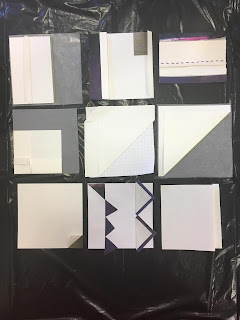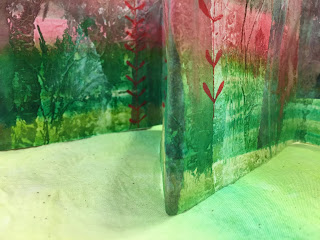Our workshop was entitled Edges and looked the potential of edges of paper, card or fabric. Sheila had asked us to chose a colour scheme and bring some photos of our choice. I decided on red and green as I'd recently returned from a fabulous holiday in Costa Rica rain forests which I felt represented the vegetation and the tropical flowers there.
In the work shop we started by choosing a word with which to work and use for our edges. I chose 'fold' and was intrigued by the effects once I got the hang of it!
We took 9 squares of papers / card and worked on them using our chosen word
We cut, tore, ripped, stitched, made rubbings of the surfaces with various mediums etc and then drew around them, stacked them and drew the resulting shapes again!
Charcoal rubbing:
We then experimented with larger sheets of paper to create interesting surfaces with Gesso, white emulsion, candle wax, bubble wrap, stamps, paint, oil pastels, text, photos, screen printing, stencils. All great fun!
These provided great ways of covering the papers before we folded them into beautiful and exciting concertina books.
This last was my favourite as this sheet :
was transformed into this beautiful book full of pages like this
We had to choose one page to take forward as an inspiration for a design on fabric:
I got this far before Summer School came to an end.
Calico with white emulsion and Koh-i-dor paints, screen printing, printing with bubble wrap and natural sponges, tissue paper colograph using sprigs of leaves and stems from outside applied with acrylic wax plus chiffon fabric laid in strips across. Some beginnings of stitching!
When I got home I decided to make some edges more based on my holiday to Costa Rica. These magnificent Emperadora flowers were growing just by our cabin balcony in La Fortuna, Costa Rica and were frequently visited by Hummingbirds coming to feed on the nectar. I felt it was so humbling to see such beauty and this image has stayed with me ever since. Sadly it wasn't possible to photograph the Hummingbirds feeding as they were so swift!
My Emperadora 'edges'
I moved the papers to repeat. Interesting shapes resulted.
I used these shapes as inspiration in completion of my final piece.
I'd been experimenting and playing with how to take this work forward using a Emporadora stencil shape as a view finder and loved the patterns which were showing through so I used a sheet of Inkjetprinting with silk to reproduce an image of my work to use for making more shapes for applique and reverse applique.
Detail:
I'm very pleased with this as I feel it sums up my excitement and sense of wonder at seeing these amazing sights in Costa Rica.
Before finishing I decided to experiment more with surfaces on paper so that I have some ideas to return to a later stage. Very pleased with these too:
I love that this technique produces such serendipitous and evocative images, I'm very happy to have resolved my Summer School project and look forward to coming back to these in the future.
Now back to coursework and my resolved piece for Mod 5 ch 12.













































